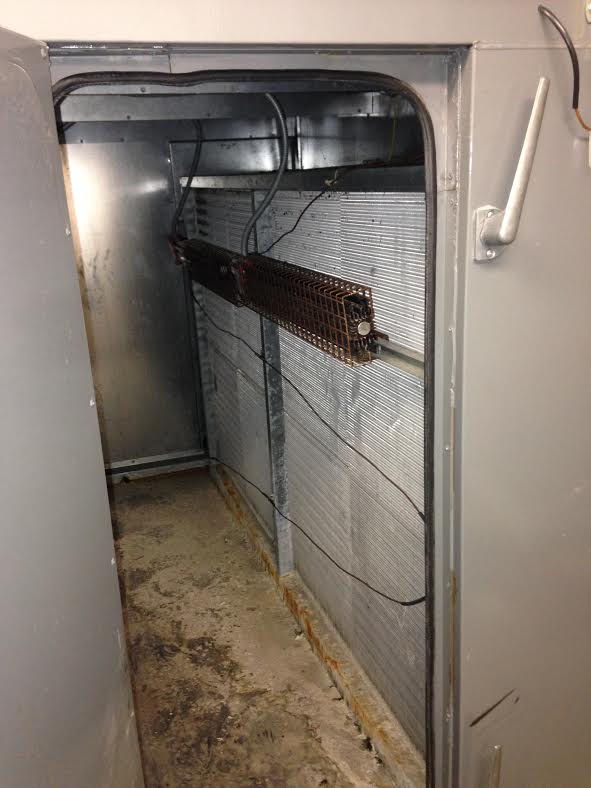
With the mornings growing colder and the morning dew turning into frost, we often see evaporator coil airflow restricted, reducing HVAC efficiency.
As the temperature quickly cools here on the East Coast signaling the end of summer, commercial building owners and property managers are met by a familiar foe – frost, the most common cause of inefficiency in evaporator coils. With the mornings growing colder and colder and the morning dew turning into frost, we often see evaporator coil airflow restricted, reducing HVAC efficiency and leading to a multitude of other issues.
The Science behind Reduced Airflow
When the evaporator coil temperature drops below the dew point, dew begins to collect on the coil’s surface. In and of itself, this is not a major issue. But when the evaporator coil temperature drops below the freezing point and dew turns into frost, we have a problem – reduced airflow.
Types of Frost
- The first thin layer of ice that forms on the evaporator coil will actually enhance HVAC efficiency by increasing the surface area of the evaporator tubes. It is the subsequent layers of frost, however, that are the problem.
- Depending on the humidity, evaporator temperature, and airflow, the subsequent layers of frost may be more crystalline or snow-like. This is known as radiant frost or hoar frost and severely reduces the evaporator’s heat-absorbing ability.
Symptoms of Reduced Airflow
|
|
Low Head Pressure
When an evaporator coil experiences reduced airflow, the heat load is also reduced and the refrigerant in the coil will fail to vaporize. With no heat load to be rejected in the condenser, condensing pressure and temperature will not need to elevate to reject heat in the ambient, resulting in low condensing pressures.
Low Discharge Temperatures
Because the liquid refrigerant fails to evaporate, it is allowed to travel past the coil and eventually into the compressor. This can cause flooding and the compression stroke could contain liquid entrained with vapor, known as wet compression. This will syphon heat from the compressor to vaporize any remaining liquid, leaving a colder discharge temperature. This is a sure sign of restricted airflow.
Low Condenser Splits
With condensing pressures and temperatures low, the condensing split will be low because the condenser does not have to elevate its temperature to reject the small heat load.
Cold Compressor Crankcase
Since the compressor superheat is low, the compressor can sometimes flood during the on cycle, resulting in liquid refrigerant in the compressor’s crankcase. This will need to boil off, flashing the oil and causing compressor damage.
If this is the case, the crankcase will be cold to the touch and may even sweat or frost.
Low evaporator (Suction) Pressures
Because of the reduced heat load in the evaporator coil, the refrigerant vaporization rate will be greatly reduced, leading to lower vapor pressures.
Low Superheats
Because of the reduced the heat load on the evaporator coil, liquid refrigerant will fail to fully vaporize, as we have already said. This can cause the saturated vapor point in the evaporator to crawl down past the end of the evaporator, leading to the thermostatic expansion valve (TXV) losing control.
High to Normal Amp Draw
Because the liquid refrigerant fails to full vaporize, the density of the refrigerant coming from the suction line will be high. This will require the compressor to work harder and the amp draw may be higher than normal.
Proactive HAVC Maintenance Prevents Airflow and Frost Problems on Evaporator Coils
HVAC systems account for 40% to 70% of a commercial building’s energy bill. By implementing an ongoing HVAC preventive maintenance plan, you can greatly reduce energy use, by as much as 20%. Crockett Facilities Services, Inc. (CFSI) can help. CFSI is an award-winning mechanical contractor servicing Maryland, Virginia and Washington, DC. We service all types of HVAC equipment, including packaged terminal air conditioners (PTACs), air handling units (AHUs), rooftop units (RTUs), chillers, boilers, heat pumps and mission-critical computer room air conditioners (CRACs).
Request a Quote for Annual HVAC Preventive Maintenance Plan
To learn more about how Crockett Facilities Services, Inc. can assist your and Building Automation efforts, please contact CFSI at 202.600.2787 or sales@crockett-facilities.com.
Like us on Facebook; follow us on LinkedIn, Twitter, and Google+ and follow our weekly blogs.
Source:
